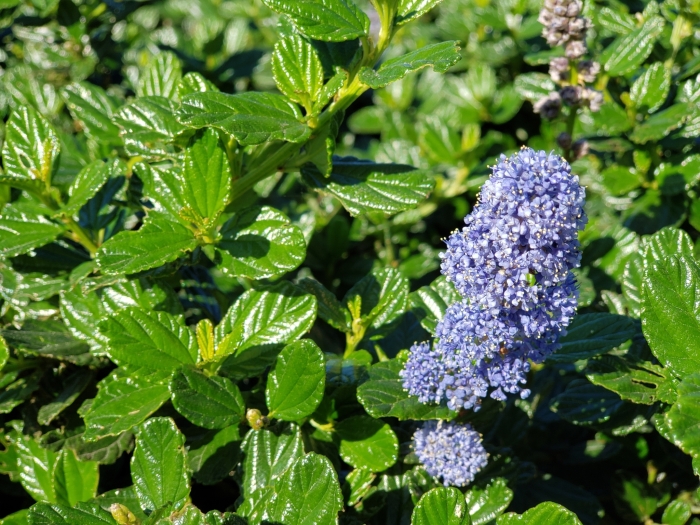Blueblossom
(Ceanothus thyrsiflorus)
Blueblossom (Ceanothus thyrsiflorus)
/
/

karangattu
Public Domain
Image By:
karangattu
Recorded By:
Copyright:
Public Domain
Copyright Notice:
Photo by: karangattu | License Type: Public Domain | License URL: http://creativecommons.org/publicdomain/zero/1.0/ | Rights Holder: karangattu | Publisher: iNaturalist | Date Created: 2018-12-13T12:36:14-08:00 |







































































































Estimated Native Range
Summary
Ceanothus thyrsiflorus, commonly known as Blueblossom, is an evergreen shrub or small tree native to coastal California and Oregon, where it thrives in mixed evergreen forests, coastal scrub, and chaparral. It typically grows to a height and width of more than 6 meters (20 feet), featuring a dense, rounded form. The foliage consists of glossy green leaves that are about 4 centimeters (1+1⁄2 inches) long. In spring, Blueblossom produces profuse clusters of tiny, fragrant flowers that range in color from various shades of blue to nearly white, which are highly attractive to pollinators such as bees and butterflies.
Blueblossom is valued for its drought tolerance, low maintenance requirements, and the abundant, showy flowers that make it a popular choice for ornamental use in gardens, especially in xeriscaping. It is also used for slope stabilization and as a hedge or screen due to its dense growth habit. This plant prefers a warm, sheltered position in full sun and can adapt to a variety of soil conditions, though it does best in well-drained soils. While it tolerates low or medium amounts of water, overwatering or poor drainage can lead to root rot. It is generally pest and disease-resistant, but it can be susceptible to fungal diseases in humid conditions. Blueblossom is not known for aggressive roots or significant invasiveness, but it can self-seed in favorable conditions.CC BY-SA 4.0
Blueblossom is valued for its drought tolerance, low maintenance requirements, and the abundant, showy flowers that make it a popular choice for ornamental use in gardens, especially in xeriscaping. It is also used for slope stabilization and as a hedge or screen due to its dense growth habit. This plant prefers a warm, sheltered position in full sun and can adapt to a variety of soil conditions, though it does best in well-drained soils. While it tolerates low or medium amounts of water, overwatering or poor drainage can lead to root rot. It is generally pest and disease-resistant, but it can be susceptible to fungal diseases in humid conditions. Blueblossom is not known for aggressive roots or significant invasiveness, but it can self-seed in favorable conditions.CC BY-SA 4.0
Plant Description
- Plant Type: Shrub
- Height: 4-12 feet
- Width: 4-12 feet
- Growth Rate: Moderate
- Flower Color: Blue, Purple, White
- Flowering Season: Spring
- Leaf Retention: Evergreen
Growth Requirements
- Sun: Full Sun, Part Shade
- Water: Low
- Drainage: Medium, Fast
Common Uses
Bank Stabilization, Bee Garden, Bird Garden, Border Plant, Butterfly Garden, Deer Resistant, Drought Tolerant, Erosion Control, Fragrant, Hedges, Hummingbird Garden, Low Maintenance, Potted Plant, Rock Garden, Showy Flowers, Street Planting
Natural Habitat
Native to mixed evergreen forests, coastal scrub, and chaparral
Other Names
Common Names: California-Lilac , Blue Blossum Ceanothus , Bluebrush
Scientific Names: Ceanothus thyrsiflorus , Ceanothus thyrsiflorus var. thyrsiflorus , Ceanothus thyrsiflorus var. repens , Ceanothus elegans , Ceanothus thyrsiflorus var. chandleri , Forrestia thyrsoides
GBIF Accepted Name: Ceanothus thyrsiflorus Eschw.